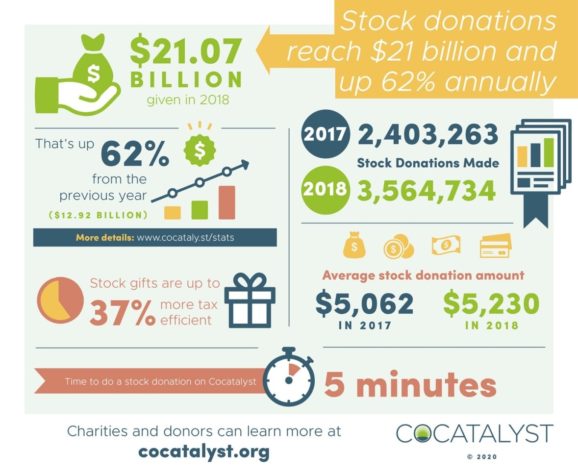How Stock Donations Can Help Nonprofits

With the recent COVID-19 pandemic happening around the world, donor volumes are being impacted in the United States. Donations in 2020 are trending flat and may go down. Congress passed in the CARES Act measures to incentivize more giving through increases tax deduction limits as a percentage of income and a $300 deduction before the deduction is calculated.
Nevertheless, in an environment where many are struggling to make ends to meet, charities and nonprofit organizations’ role becomes even more critical. Charities should be taking dramatic measures to make it easier for donors to give.
Donor behavior has also been changing the last few years, and people are adopting different types and methods of donations. For instance, stock donations are quickly growing by high double-digit rates, while other forms are stagnant or experiencing less growth. The increase in stock donations can be attributed in large part to the wide range of benefits offered by this type of giving.
What is the Value of Stock Donations?
While your charity might be accustomed to physical items and cash donations, many benefits from stock donations will resonate with your donors, resulting in more donations.
When an individual donates appreciated securities, they receive a deduction for the Fair Market Value of the stock, similar to giving with cash or credit card. However, donors also avoid capital gains taxes on the increase in value. If the donor sold their stock, they would have had to pay taxes up to 37% on the profit, even if they intended to give the cash proceeds to a charity.
However, when an individual donates stock held for a year, there are no taxes involved. The charity of this donation can hold on to these stocks or sell them immediately with paying that 37% tax burden.
Since stock donation offers a multitude of tax benefits, donors will appreciate an easy way to donate stocks to nonprofit organizations. Hence, nonprofits and charity organizations should be ready to accept stocks to receive more money in donations.
Interesting Facts about Recent Stock Donations

Infographic source: Cocatalyst Articles
Many people, including celebrities and business owners, choose stock donations when giving to charitable organizations. This trend has been accelerating – stock donations went up 62% from 2017 to 2018, reaching $21 billion. The average stock donation amount in 2017 was $5,062 and increased to $5,230 in 2018.
For instance, Jack Dorsey, the CEO of Twitter, used stock for his recent $1 billion donation in Square stock to several nonprofit causes, including helping in coronavirus relief efforts. Since Dorsey is the co-founder of Square, he owns a large part of the company and the donation makes around 28% of his total wealth. Being the company’s founder, he did not have to pay for his shares, and a large percentage of his stocks are pure profit. If he gave to charities with cash, he would have owed $370 million in future taxes to the government.
That is the magic of stock donation. If Dorsey chose to sell his Twitter or Square stock for a nonprofit or charity organization, he would have to pay significantly more money in taxes.
Educating Donors on Stock Giving
As a nonprofit organization,educating your donors on the benefits of an appreciated stock donation will go a long way in helping you receive more donations. The stock becomes the nonprofit’s asset once transferred to that organization. When the nonprofit receives the shares it records the contribution at the fair value of the stock on the date of donation.
In case the donor uses the stock to pay a pledge, the nonprofit will reduce the pledge’s balance receivable by the stock’s fair value on the received date. In case the stock’s fair value is higher than the pledge receivable balance upon receipt of the gift, the nonprofit will record a contribution for the difference.
Here are a few easy ways to educate your donors on the benefits of donating stocks:
Use a Stock Donation Tool
Your donors do not have to stick to manual stock donation methods. There are stock donation tools that dramatically simplify the process and shorten the time for making a stock donation.
Send Frequent Emails
Create an email marketing campaign to encourage donors to consider stock donations. Sending emails regularly to donors will increase your chances of receiving more donations.
Send a Reminder in December
You can send reminders in early December to let donors know they can use stock donations to reduce future tax obligations.
Promote Stock Giving on your Website
Placing a clear reference on your website helps donors know that your nonprofit is willing to accept stock donations. For instance, you can add something like this on your website.
Dear Donors! Our nonprofit organization encourages donors to make stock donations over cash or credit card. Such donations are up to 37% more tax efficient since they will remove your capital gains taxes and are fully deductible if they have been held for more than a year. If you prefer to keep your portfolio as is, please consider donating the appreciated stocks to our organization and use cash to purchase the same amount through your brokerage account.
The Stock Donation Process
Setting up and handling stock donations can be long and tedious. This lengthy process makes donating stock far less convenient than giving cash or credit card because there are considerable setup and processing steps for each transaction. We explain the process here below, and there are also stock donation tools available that can streamline the process.
Stock Donation Set Up for Charities and Transaction Processing
Here are a few things that a nonprofit organization must do to receive conventional stock donations.
- Set up a brokerage account using one of the several providers in the market. Nonprofit organizations usually get lower fees than companies or individuals.
- Create an instruction letter to include in response to inquiries from donors about making a stock donation. However, do not add the instruction details to your website as it could lead to forgery and theft as this letter has identifying information such as your name, broker’s name, account number, transfer number, contact number, and fax numbers.
- Create an investment policy if you wish to receive specific stock donations. Think about whether you want to hold onto the stocks you receive or sell them as soon as you get donations. Make sure your donors are aware of your policies.
- Follow these steps when receiving a donation:
- Check the brokerage account daily. The value of the donation should match the fair market value for the day. If you don’t sell the shares on the day they arrive, you may need to log the difference between the donor’s fair market value and the amount your organization sold the donated stock for.
- Send out a ‘Thank you’ letter to the donor for all gifts over $250. The acknowledgment letter should be sent within thirty days of receiving the donation.
- Ensure that you track all your donations through your accounting or fundraising CRM program. Include all information about the receipt date, the value of the stock, number of shares, date of sale, or other relevant details. You will need to report the amount, number, and in some cases, security name to on your IRS 990 forms.
Because of all these steps, only about half of 1 percent of all US charities accept stock donations. However, while more involved than other types of donations, as I’ve explained above, the added work can certainly be worth it!
Stock Donation Process for Donors
Here are the steps that donors must take to donate stock. There are also tools online to demystify and shorten these steps to 5 minutes covered in this “How to Donate Appreciated Stock to a Charity” guide.
- Donors must contact their broker for a stock donation transfer form. It’s imperative to work closely with the donor during the process to ensure they have included the right information for your organization as incorrect information can delay or stall the donation. Once the donor fills out the form, they need to fax it in to their broker.
- Donors then ask for a confirmation report from the nonprofit organization once their stock donation process finishes. This report features all information such as the date of transfer and the value of the donation.
Final Thoughts
The need for consistent donations is growing by the day. Nonprofit organizations should add stock donations and communicate this option to their donors on a regular and timely basis. To make this process easy for donors and back office, read this guide to learn more about how to accept stock donations for your charity.


